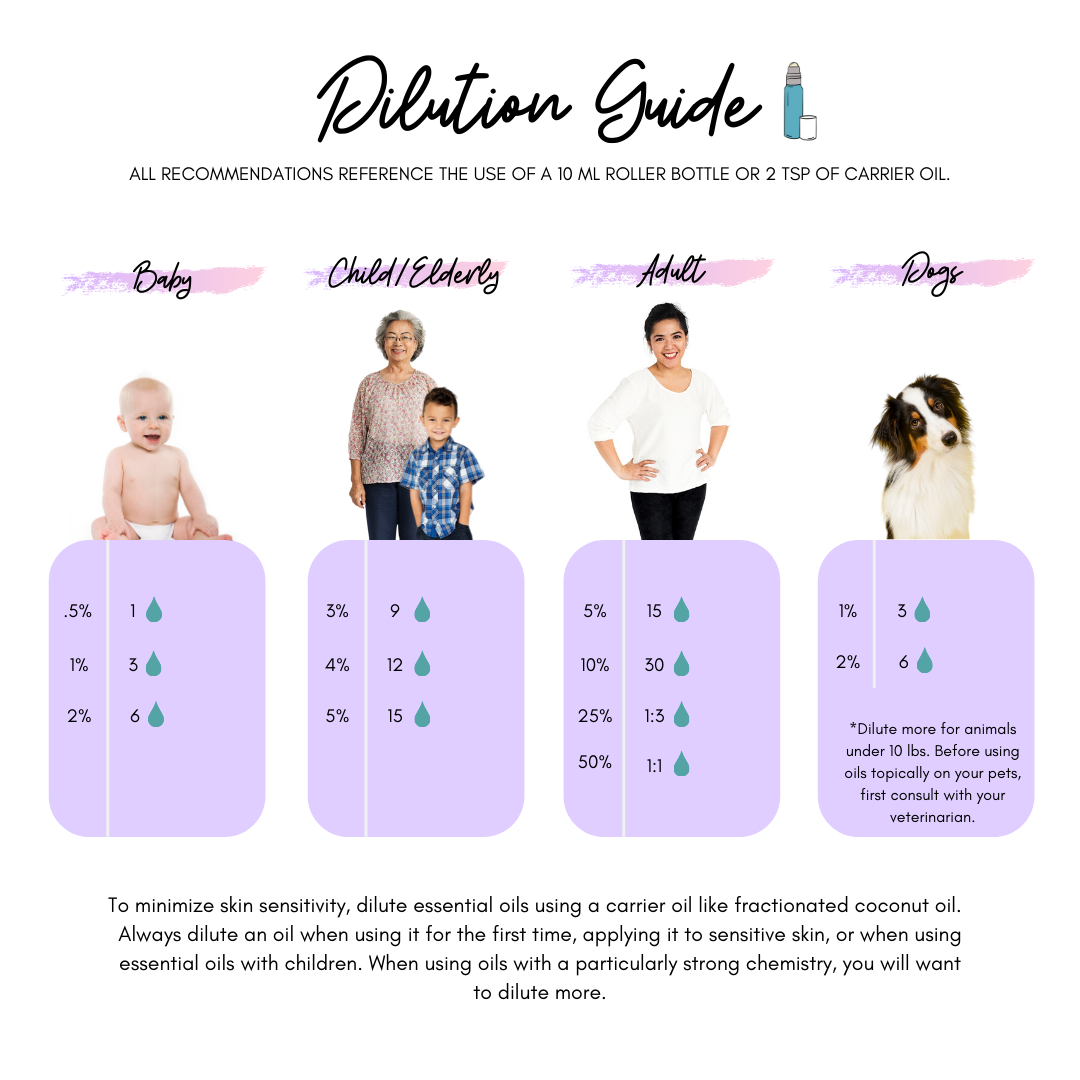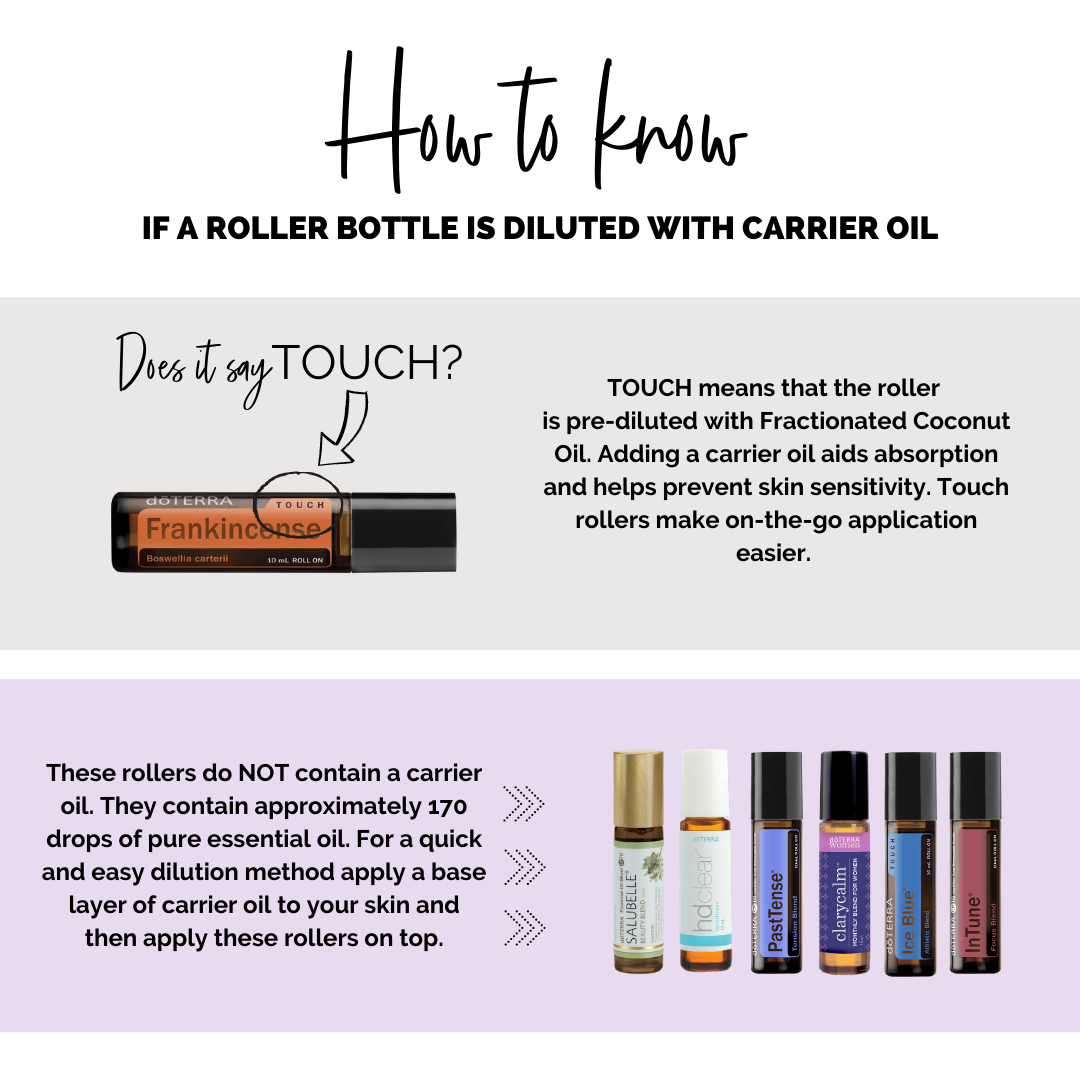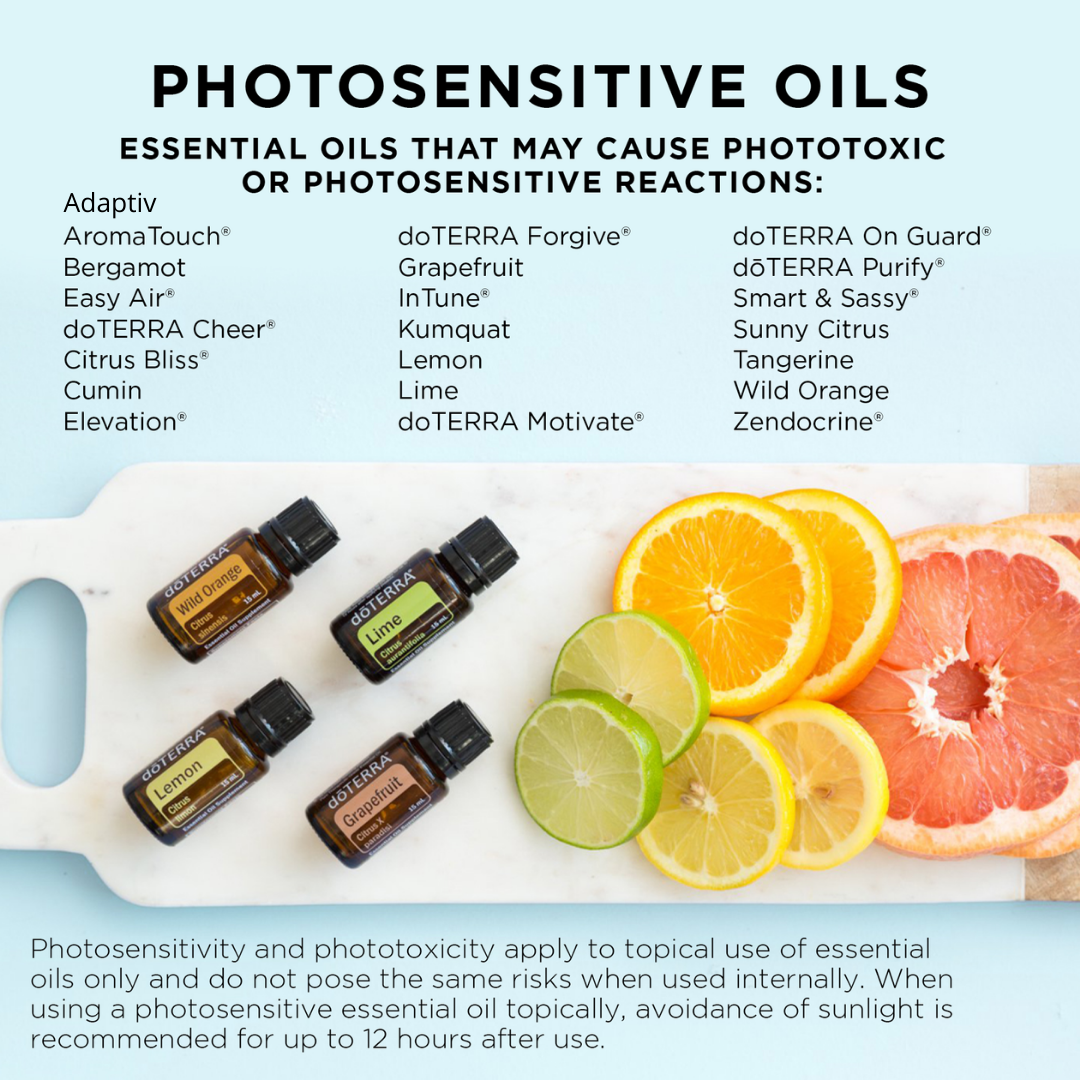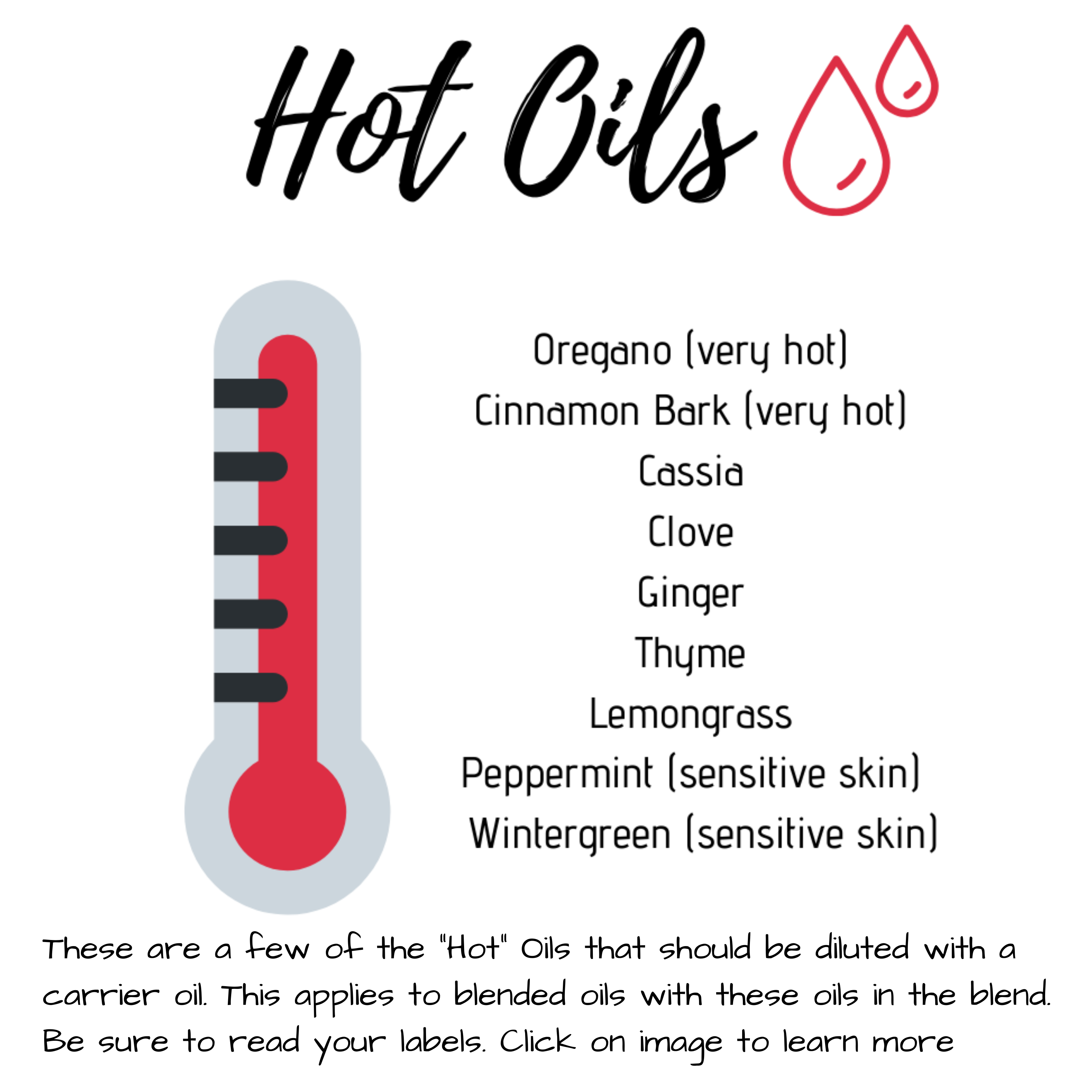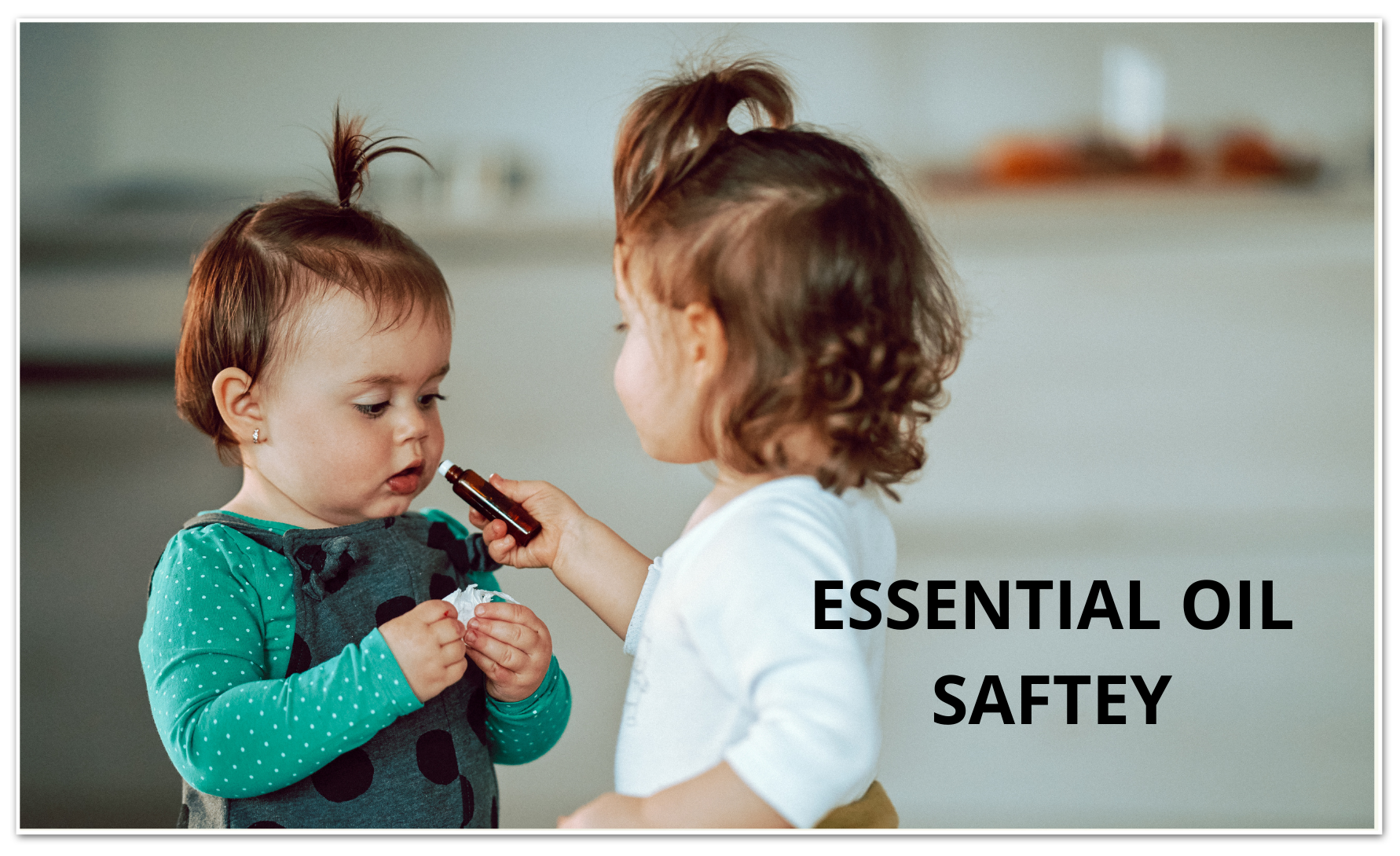
Essential oils are very safe and easy to use. However, it is
important to remember that pure essential oils are highly
concentrated plant extracts and should be used with care.
BASIC SKIN TEST
For those with sensitive skin or prone to irritation, a skin test can help prevent an
unwanted reaction. Place a small amount of carrier oil such as coconut or olive oil,
followed by a small amount of the essential oil on the inside of the elbow, underside of
the forearm, or wrist. After approximately 1 hour, check the area(s) for any type of
reaction. If an essential oil causes irritation, further diluting the oil with a carrier, or
applying a carrier first, then followed by the essential oil will usually make the oil
Most users will not react to quality, pure oils and they can be safely applied for a direct powerful effect.
Dilute with oil, not water.
If you happen to get an essential oil somewhere you did not intend, or experience
and susceptible to irritation or stinging sensations. Use a carrier oil to protect this
even hot on the skin and therefore should be diluted with a carrier oil when used
Internal Use.
Pregnancy & Nursing.
Critical health conditions.
Persons with critical health conditions can definitely benefit from essential oils, but may want to consult a healthcare professional. In general, those with epilepsy should be cautious or avoid: fennel, basil, birch and digestive blend; those with high blood
A little goes a long way.
Essential oils are pure concentrates. The higher quality the oil, the more potent it will be and smaller amounts are required. One or two drops is considered a dose. Less oil,
more often, is best. Unlike synthetic medications, you do not need to wait 4 hours
Essential oil and bath water.
One common application method is in a bath. When using undiluted oil in bath water,
use a dispersing gel (bath/shower gel can work) or epsom salts to prevent oil from
Many oils are flammable. Keep them clear of open flame, spark, or fire hazards.
unwanted reaction. Place a small amount of carrier oil such as coconut or olive oil,
followed by a small amount of the essential oil on the inside of the elbow, underside of
the forearm, or wrist. After approximately 1 hour, check the area(s) for any type of
reaction. If an essential oil causes irritation, further diluting the oil with a carrier, or
applying a carrier first, then followed by the essential oil will usually make the oil
comfortably usable.
Never apply oils directly to the eyes or ear canal.
After application, avoid rubbing the eyes, around the eyelids, handling contact lenses, or touching the interior of ones nose. The skin around the genitals and mucousmembranes areas are also sensitive and prone to irritation.
If you happen to get an essential oil somewhere you did not intend, or experience
discomfort when applying it to your skin, please use a carrier oil or pure vegetable oil to rinse or dilute the area. Using water will increase the discomfort.
Use a carrier oil with babies, children and those with sensitive skin.
Care should be used with babies, children, and the elderly. Their skin is more sensitiveand susceptible to irritation or stinging sensations. Use a carrier oil to protect this
sensitive skin against irritation. When applying oils to babies & children, ensure they will not accidentally get the oils in their eyes or mouth (bottoms of the feet and then covered with socks, or along the spine are good locations).
“Warm oils”.
Some oils, such as cinnamon, thyme, oregano, cassia and clove, can feel very warm oreven hot on the skin and therefore should be diluted with a carrier oil when used
topically, even on adults. Peppermint is a cooling oil, but is another oil you may want to dilute.
While most essential oils on the market should not be taken internally (and this warning is usually on the label), certified pure oils are labeled as dietary supplements and are safe for internal use, in small quantities. Mild oils may be taken under the tongue or in water, hot oils should be placed in capsules. Many oils may be used in cooking recipes for flavoring and/or therapeutic benefit.
While oils applied topically at ordinary levels should not be harmful, please use caution with essential oils during pregnancy. Popular oils generally considered safe to use during pregnancy include. bergamot, ginger, geranium, lavender, lemon, sandalwood, wild orange and ylang ylang, however, other oils may also be suitable; consult your healthcare provider if you have questions or concerns. Additional oils may be helpful during and after delivery. Internal use of peppermint can reduce milk supply in some mothers, so you may want to avoid it prior to delivery and while nursing.
Persons with critical health conditions can definitely benefit from essential oils, but may want to consult a healthcare professional. In general, those with epilepsy should be cautious or avoid: fennel, basil, birch and digestive blend; those with high blood
pressure should be cautious or avoid thyme and rosemary.
Essential oils are pure concentrates. The higher quality the oil, the more potent it will be and smaller amounts are required. One or two drops is considered a dose. Less oil,
more often, is best. Unlike synthetic medications, you do not need to wait 4 hours
before using an oil again. Apply the oil; if there is still discomfort, apply more again in a few minutes.
One common application method is in a bath. When using undiluted oil in bath water,
use a dispersing gel (bath/shower gel can work) or epsom salts to prevent oil from
pooling as a concentrated drop in the water. Also note that oils will evaporate quickly in very hot water.
PHOTOSENSITIVE ESSENTIAL OILS
Photosensitive oils, primarily citrus oils, react to radiant energy or light such as natural sunlight, sunlamps, or other sources of UV rays.
To avoid issues with photosensitive oils, wait a minimum of six hours before exposing
Photosensitization is the process in which ultraviolet (UV) radiation combines with a
particular substance and causes chemical or biological changes. Citrus oils contain
If exposed to sunlight (which gives off UV radiation) after topical application of a
photosensitive oil, the skin may become temporarily darkly pigmented, red, or irritated.
More extreme exposure may cause hives or burns!
I know summer time is all about the citrus smells, but please avoid using the following
oils topically where UV sun exposure can occur. Diffusing is a great option or applying
under clothing!
skin where you have applied citrus oils to UV rays/sunshine.
particular substance and causes chemical or biological changes. Citrus oils contain
constituents that can cause photosensitization of the skin.
photosensitive oil, the skin may become temporarily darkly pigmented, red, or irritated.
More extreme exposure may cause hives or burns!
I know summer time is all about the citrus smells, but please avoid using the following
oils topically where UV sun exposure can occur. Diffusing is a great option or applying
under clothing!
Other Photosensitive Oils include... Arise, Beautiful, Brave, Breathe, Cheer, Citrus Bloom, Clementine, Island Mist, Red Mandarin, Slim & Sassy, Thinker, White Grapefruit, Yellow Mandarin.
STORING YOUR ESSENTIAL OILS
Essential oils are sourced from all over the world. Once distilled, they are shipped in
First, the oil is funneled into glass bottles with securely closing caps. Usually, these
Next the label is applied and the bottle is stamped with a lot number and an expiration
date. Any essential oil marked for internal use must also be marked with an expiration
date to fulfill regulatory requirements. However, the very nature and structure of
Storing essential oils properly also plays a major role in ensuring that essential oils
• Store the essential oil in room-temperature conditions and avoid exposure to
extreme temperatures (leaving oils in the car in the summer, on window sills,etc.)
large drums from their country of origin to the packaging plant where the quality testing techniques (described above) and packaging are performed. Proper packaging is a critical part of maintaining the overall efficacy of the essential oils.
glass bottles will be tinted amber or another dark shade to protect the essential oil from sunlight and other sources of UV radiation, but any glass container will work effectively if the oils are stored properly.
Any plastic parts used with essential oils (orifices, lids, etc.) should be made from high quality plastics that are number 1 (PETE) or number 2. This helps prevent erosion of the plastic that can occur with essential oils.
Next the label is applied and the bottle is stamped with a lot number and an expiration
date. Any essential oil marked for internal use must also be marked with an expiration
date to fulfill regulatory requirements. However, the very nature and structure of
essential oils makes them extremely stable.
Shelf life testing performed on essential oils has shown that essential oils maintain their efficacy even after 5–10 years or more.
maintain their efficacy and beneficial properties over time.
Here are some guidelines that should be implemented when storing essential
oils:
oils:
• Store the essential oil in room-temperature conditions and avoid exposure to
extreme temperatures (leaving oils in the car in the summer, on window sills,etc.)
• Avoid exposing the oils to direct sunlight or other sources of UV rays.
• Prevent prolonged exposure to oxygen which can cause oxidation of the oil over
time (leaving the cap unscrewed, etc.).
time (leaving the cap unscrewed, etc.).
• Tightly secure the caps after each use (prevents the oil from evaporating and
decreases exposure to oxygen).
decreases exposure to oxygen).
